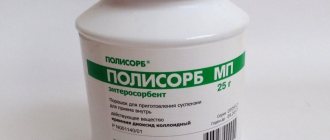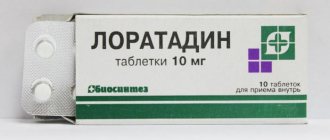The instructions for use define Fenistil drops as a means that inhibits membrane proteins to eliminate at the physiological level the pathological manifestations of the body under the influence of allergens: itching, swelling, redness. How to use correctly, taking into account age, dosage for children and adults, as well as special instructions that you need to know before use.
Fenistil drops - what is it, composition
Fenistil is a children's antihistamine drops that can be given from the first month of life. The medicine belongs to the first generation drugs, which are used to block histamines in a non-selective way.
Composition of drops
The basis of 1 ml of medicine in the form of drops is an active substance derived from phenylalkylamine, dimethindene maleate in an amount of 1 mg. Additionally, in the production of the drug the following are used:
- sodium phosphate 2-substituted, 12-water (0.016 g);
- tribasic carboxylic acid (0.005 g);
- benzoic acid (preservative – 0.001 g);
- disodium edetate (increases the permeability of the active substance through the membrane of mucous membrane cells - 0.001 g);
- sodium saccharinate (sweetener – 0.5 mg);
- propylene glycol (hygroscopic substance – 0.1 g);
- highly purified water (0.88 g).
The antihistamine is colorless and odorless and comes in a darkened glass bottle with a dispenser cap for portion measuring.
Fenistil drops: composition and properties
Fenistil is an antihistamine in liquid form with a wide spectrum of effects. The main active ingredient is dimethidene.
Fenistil in the form of drops is absorbed very quickly, so its effectiveness in cases of acute allergic reactions is especially great. This is one of the few antiallergic drugs that are allowed to be used by infants starting from one month of age.
The effectiveness of the drug is based on its ability to block H1 receptors, being a histamine antagonist.
Fenistil has antikinin properties, that is, it blocks the effect of quinines, helps reduce capillary permeability and relieves bronchial edema.
Under the influence of this remedy, urticaria and other types of rashes quickly disappear, swelling decreases, itching and irritation of the skin and mucous membranes disappear. The patient feels much better and gradually returns to normal.
Pharmacological action and pharmacokinetics
How does the drug work?
- Fenistil drops, after oral administration, rapidly suppress the production of histamine by the body. This is necessary in order to relieve the baby’s unpleasant itching, redness, eliminate swelling and ultimately reduce capillary permeability.
- Dimetindene has the ability to quickly penetrate tissue, so the effect of the drops is noticeable within the first 15 minutes, which is important in case of emergency assistance (for example, with Quincke's edema).
- The drug will reach its maximum concentration within two hours. The half-life can be from 6 hours.
If Fenistil drops are used during the day, a mild sedative effect may be observed.
| Suction | After oral administration, it is absorbed quickly and quite completely. Cmax in blood plasma is achieved within 2 hours. Bioavailability is about 70%. |
| Distribution | Plasma protein binding is 90%. Penetrates well into tissues. |
| Metabolism | Metabolized in the liver by hydroxylation and methoxylation. |
| Removal | T1/2 is 6 hours. It is excreted in bile and urine (90% in the form of a metabolite, 10% unchanged). |
Tsetrin
This analogue is cheaper. Its cost in Russia is within 185 rubles per package. Cetrin is not available in external forms, only for systemic oral use. The available forms of release on the market are tablets and syrup. The drug belongs to the classical antihistamines of the second generation and has a wide range of uses. Tablets are prescribed for the treatment of skin manifestations of allergies - urticaria, itching, swelling, neurodermatitis and atopic dermatitis.
The syrup form is used in children, since they do not like to swallow tablets. Syrup is prescribed for hay fever, conjunctivitis of an allergic nature, urticaria, allergic rhinitis, Quincke's edema. Side effects of the drug are typical for the group of second-generation antihistamines. These include: headache, stomach discomfort, dizziness, mild drowsiness. The dosage is selected individually, depending on medical indications.
Indications for use for children
The main indications for the use of Fenistil in children are various allergic reactions, regardless of the area of their localization:
- allergies to food or drugs;
- atopic dermatitis (diathesis);
- seasonal hay fever;
- angioedema;
- itching of the skin due to an allergic or infectious cause;
- reaction to an insect bite;
- prevention of allergic diseases.
The list of indications for prescribing gel and emulsion is somewhat smaller, since they are used only externally, mainly to eliminate allergy symptoms. Indications for their use are itching and redness of the skin of various origins:
- against the background of allergies;
- for infectious diseases (rubella, chickenpox);
- for neurodermatoses.
Vibrocil
The best analogue of the drug is Vibrocil, although it is by no means cheap. Its price fluctuates around 270 rubles per package, yes cheaper, but not much. Vibrocil is an antihistamine for topical use. Once on the nasal mucosa, vibrocil exhibits an immediate vasoconstrictor effect, as a result of which the runny nose disappears. It should be noted that Vibrocil has some advantage in that it has a combined composition. The fact is that when a runny nose is of an uncertain nature, then this drug is best suited. The active ingredients are the vasoconstrictor alpha-adrenergic stimulant phenylephrine and the antihistamine dimethindene. The drug will help in the following cases:
- Swelling of the nasal mucosa
- Sinusitis and rhinitis - acute and chronic form
- Allergic seasonal runny nose.
Vibrocil has three forms of release: nasal drops, intranasal spray and gel for intranasal administration. A child can use the gel and spray from the age of six, and the drops can be instilled even into infants, which means the medication is relatively safe and will not cause harm if used correctly. There are no systemic side effects; in rare cases, dryness and burning in the nose may occur.
Contraindications ⛔
Fenistil drops have a number of contraindications, so before starting to use the drug, you should consult your doctor and carefully read the attached leaflet. Drops should not be taken orally if the patient has one or more conditions:
- bronchial asthma;
- angle-closure glaucoma;
- pathological growth of the prostate gland in men;
- children under 1 month of age, especially for premature babies or babies born with low body weight;
- individual intolerance to the components of the drug;
- pregnancy in the first trimester;
- breastfeeding period.
⛔With special caution, the drug Fenistil in the form of drops is prescribed to children under 1 year old, as children have a high risk of respiratory dysfunction while taking the drug.
Psilo-balm
Psilo-balm is an antihistamine component for external use, which is available only in gel form. The gel has a semi-liquid consistency, transparent, completely colorless and odorless. The active ingredient is diphenhydramine. The average cost of a German drug in Russia is 257 rubles per package. With the help of psilo-balm you can effectively combat the negative manifestations of an allergic nature and traumatic skin lesions.
List of prescriptions: urticaria, sunburn of the first degree of severity, traces of mosquito and wasp bites, eczema accompanied by itching, chickenpox, itchy skin of various origins, contact dermatitis, irritation on the body of an allergic nature. The product should be applied 2 times a day directly to the affected area for children over two years of age and adults.
Fenistil drops for children and adults: instructions for use and correct dosage
Fenistil drops are approved for use in children from 1 month. There is a simplified dosage scheme for drops, depending on the age of the child:
| Child's age | Single dose of Fenistil | Daily dose |
| Children from 1 month to 1 year | 3-10 drops | 9-30 drops |
| Children from 1 year to 3 years | 10-15 drops | 30-45 drops |
| Children from 3 to 12 years old | 15-20 drops | 45-60 drops |
If the child has normal weight and development, you can use this scheme. If the child is premature and weakened, suffers from concomitant diseases, it is better to calculate the dosage accurately, focusing on body weight. This is done as follows: the daily dose of Fenistil is 0.1 mg per 1 kg of body weight. First, we calculate the daily dose based on this ratio and the actual weight of the child.
For adult patients and adolescents who have reached the age of twelve, the daily dose can be prescribed in the amount of 3 to 6 milligrams (60-120 drops), which is divided into three doses of 20-40 drops three times a day.










